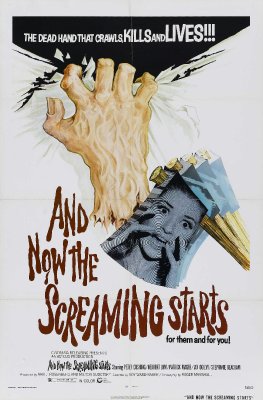
AND NOW THE SCREAMING STARTS
UK, 1973, 94 minutes, Colour.
Peter Cushing, Herbert Lom, Ian Ogilvy, Stephanie Beacham, Patrick Magee, Guy Rolfe, Rosalie Crutchley.
Directed by Roy Ward Baker.
At one stage this film had the alternate title I Have No Mouth But I Must Scream. However, this is a familiar kind of horror story from the British studio, Amicus, maker of such compendium films as Tales From The Crypt. It rivalled Hammer Studios, which led the way in horror, as well as Tygon, which employed many of the same actors. In fact, Peter Cushing, the regular at all these studios, appears as Doctor Pope in this film. The film has a very strong cast with a sinister Herbert Lom as an ancestor of the put-upon bride, played by Stephanie Beecham before she became a star on television and played character roles in later British films. Her husband is played by Ian Ogilvie, television’s The Saint. Veterans like Patrick Magee, Guy Rolfe and Rosalie Crutchley are also featured in the cast.
The film is set in an eerie manor at the end of the 18th century in rural England. There are the expected frights, ghosts and bouts of violence. It is similar to many films made at this period.
Direction is by Roy Ward Baker who made some films in the United States in the early 50s, Inferno, Don’t Bother to Knock with Marilyn Monroe, The House in the Square (I’ll Never Forget You) as well as some substantial British films including The Singer Not the Song and Flame in the Streets. His main career was in television and making horror films like this one.
1. Audience expectations from the title? Too sensational? horror thriller? Realism or not?
2. The quality of the film in the horror genre? The thriller characteristics. mystery characteristics? The use of horror and thriller conventions?
3. Comment on the contribution of the technical aspects: colour, creation of atmosphere, the portraits, the mysterious portrait, ghee creeping hand, the apparitions etc. Colour and trick photography?
4. The value of the eighteenth century atmosphere? The house, styles and manner, the countryside, class distinctions, doctors and lawyers? Religion and curses, superstition?
5. The flashback techniques and their contribution to the plot? Were they sufficient for explanation? Were they well placed? How credible did they make the plot?
6. The nature of the curse and audience response to it? Though mysterious, was it plausible? How did the film communicate the plausibility?
7. How well did the film focus on the Fen? Griffans? The opening journey, the wedding, Catherine's fear of the portraits, the story of the grandfather, the rape and the evil curse, the apparition on the .wedding night and the cursed child, the murders? Charles and his not telling the truth? Catherine and her fear?
8. Charles as hero: an eighteenth century hero. silence about the curse? As a person, his final going berserk and violence?
9. Catherine and audience identification with her? The atmosphere of her arrival, her being terrified, continual fear, her fear of madness, murders, the baby and her attachment to it?
10. The contribution of the minor characters the lawyer, the maid, the aunt? The doctor? Their deaths?
11. How interesting a character was Silas? Audience sympathy for him? his wedding night, the curse, young Silas and the revenge? The menace and the fear?
12. The character of doctor Pope, science and scepticism, investigating curses? A stock fear of horror films? his contribution to the plot? How did the plot move to its culmination and involvement audience response?
14. The insight into the vengeance theme, evil and its consequences, the Scriptural quotation at the end and its appropriateness?
15. Why do audiences enjoy this kind of horror film?